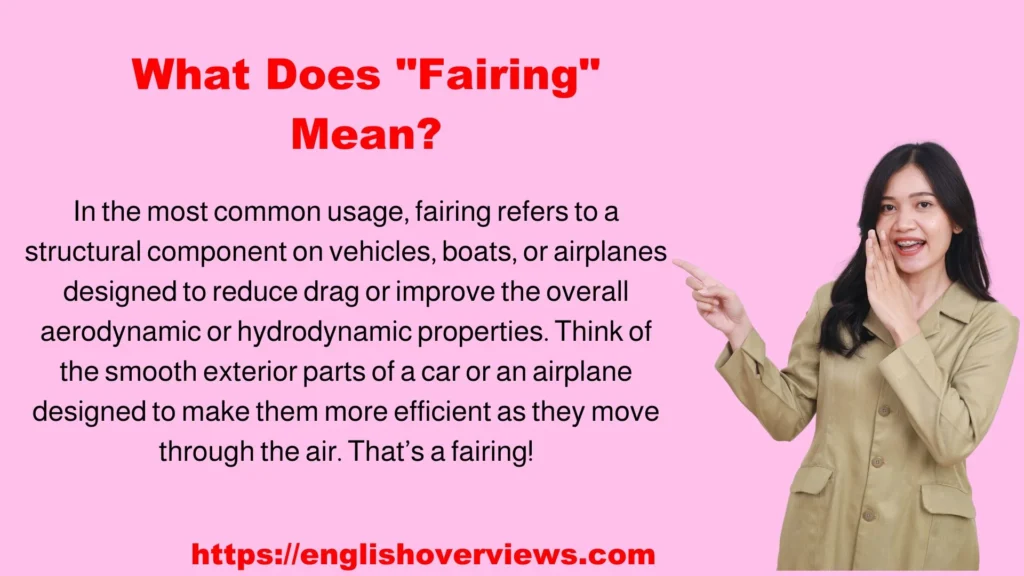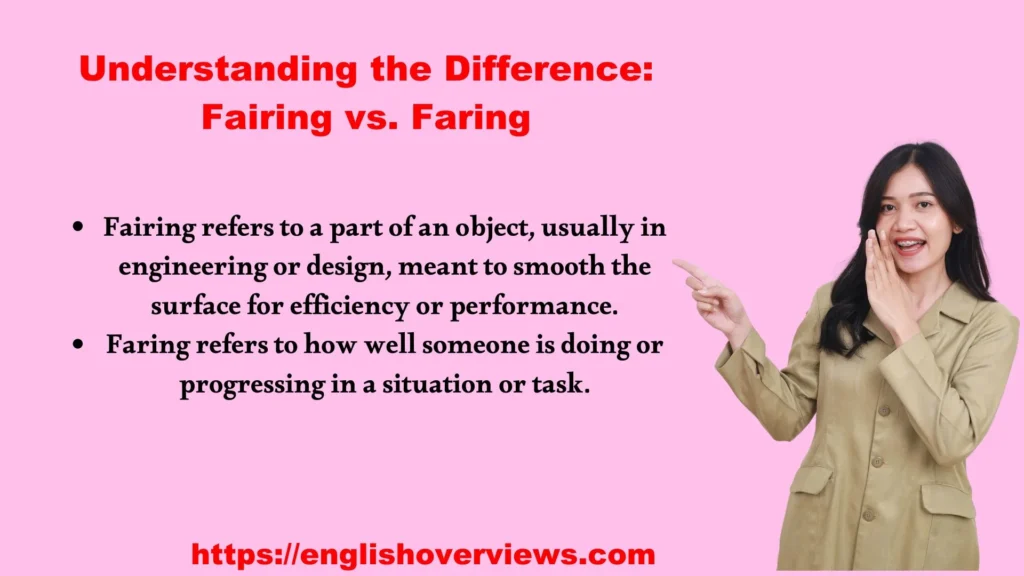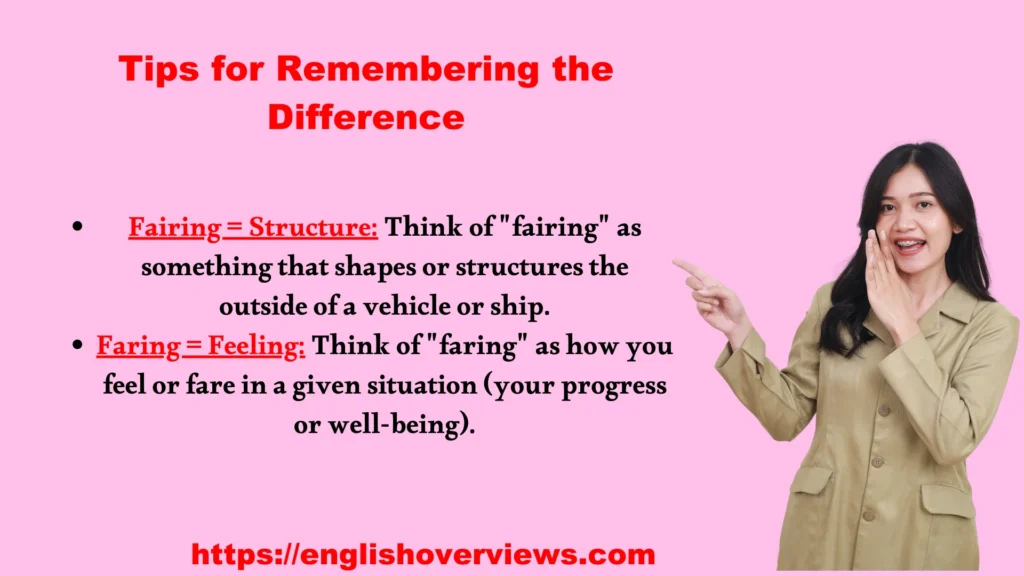When it comes to the phrases “How are you fairing?” and “How are you faring?” many people find themselves puzzled by the subtle yet important distinction between these two words. They sound so similar, but the truth is, they have entirely different meanings and applications.
In this post, we will dive deep into the difference between “fairing” and “faring,” explain when and how to use each term correctly, and help you avoid the common mistakes that can confuse the two.
Whether you’re writing an essay, a casual email, or just having a conversation, understanding how to use these words properly will not only improve your language skills but also make you sound more polished and professional. So, let’s break it down!
What Does “Fairing” Mean?

In the most common usage, fairing refers to a structural component on vehicles, boats, or airplanes designed to reduce drag or improve the overall aerodynamic or hydrodynamic properties. Think of the smooth exterior parts of a car or an airplane designed to make them more efficient as they move through the air. That’s a fairing!
Definition Breakdown:
- Fairing: A part or structure that helps smooth or streamline the body of a vehicle, aircraft, or vessel to improve performance.
- Usage: Primarily used in engineering, aerodynamics, and nautical contexts.
Example sentences:
- “The fairing on the plane helped reduce air resistance.”
- “After the crash, the motorcycle’s fairing was replaced with a newer model.”
- “The yacht’s fairing needed repairs to maintain its speed in the race.”
Examples of “Fairing” in Context
To understand “fairing” better, let’s look at some practical examples where the term is commonly used.
- Automobiles: Many modern vehicles have aerodynamic fairings attached to them. This helps in reducing the drag and improving fuel efficiency. A smooth exterior reduces friction, making the vehicle more efficient.
- Airplanes: In aviation, fairings are used to cover parts like engines or wheel wells. These are designed to improve the airflow and increase the aircraft’s speed.
- “The airplane’s fairing was repaired after it sustained damage from turbulence.”
- Boats and Ships: Fairings in nautical contexts refer to the parts of a ship or boat that reduce water resistance, allowing for smoother sailing.
- “The ship’s fairing was damaged, causing a delay in its journey.”
What Does “Faring” Mean?
On the other hand, faring has a completely different meaning. Unlike “fairing,” which is a physical object, faring relates to how a person or group is doing in terms of well-being, progress, or condition. It is often used to ask or describe how someone is coping with a situation or how something is developing over time.
Definition Breakdown:
- Faring: Describes how well someone is doing, often in reference to life’s circumstances or progress in a specific task or challenge.
- Usage: Commonly used in day-to-day conversations, formal writing, and literature.
Example sentences:
- “How are you faring with your new job?”
- “She’s faring much better now that the storm has passed.”
- “How are you faring on the project? Are you meeting the deadlines?”
Examples of “Faring” in Context
To make things clearer, let’s dive into some examples where “faring” is used appropriately.
- Personal Well-being: When you ask someone how they’re faring, you’re essentially asking how they’re coping or doing in life or in a particular circumstance.
- “I’m faring better than I expected after the surgery.”
- Progress or Outcome: In a professional context, asking how someone is faring can relate to how they’re doing in terms of a task or project.
- “The team is faring poorly in the tournament, but they are giving their best effort.”
- Literary Context: Authors often use “faring” in literature to describe characters’ emotional or physical states over time.
- “As the story unfolded, we saw how the characters were faring in their journey.”
Understanding the Difference: Fairing vs. Faring

Now that we’ve defined both words, let’s explore the key difference between fairing and faring. The crucial distinction lies in their meanings:
- Fairing refers to a part of an object, usually in engineering or design, meant to smooth the surface for efficiency or performance.
- Faring refers to how well someone is doing or progressing in a situation or task.
| Fairing | Faring |
| A physical structure designed to improve efficiency or streamline an object | Refers to how well a person or thing is progressing or coping with a situation |
| Commonly used in engineering, vehicles, ships, and aircraft | Used in daily conversation, literature, and discussions of well-being or progress |
| Example: “The fairing reduced drag on the race car.” | Example: “How are you faring with your studies?” |
Contextual Understanding: When to Use Each Term
Let’s break down the correct contexts for using fairing and faring to avoid any confusion.
When to Use “Fairing”:
- In discussions related to design, engineering, or vehicles: Think of scenarios involving airplanes, boats, or cars where the term refers to a smooth or aerodynamic component.
- In technical or professional contexts: Fairing is often used in fields like aerodynamics, mechanics, and marine engineering.
Examples:
- “The fairing of the motorcycle protected the engine from debris.”
- “The designer focused on improving the fairing of the vehicle to reduce air resistance.”
When to Use “Faring”:
- In everyday conversations about how someone is doing or progressing: This is the more common phrase you’ll use in both casual and formal settings when discussing someone’s situation, progress, or well-being.
- In literature or historical texts: “Faring” is often used to describe how people or characters are coping with challenges or obstacles.
Examples:
- “How are you faring with your new responsibilities at work?”
- “I’m faring well, thank you for asking!”
Common Mistakes and Clarifications
Despite the clear differences between “fairing” and “faring,” many people still confuse these two terms. Let’s highlight some of the most common mistakes and how to avoid them.
1. Using “Fairing” in place of “Faring”
- Mistake: “How are you fairing today?”
- Why it’s wrong: Since “fairing” refers to a part of a vehicle or object, it doesn’t make sense to use it in this context.
- Correct usage: “How are you faring today?”
2. Using “Faring” in place of “Fairing”
- Mistake: “The airplane’s faring was damaged.”
- Why it’s wrong: “Faring” has nothing to do with structural components, so this sentence would be confusing.
- Correct usage: “The airplane’s fairing was damaged.”
Tips for Correct Usage:
- Think about context: Is it an object? Then it’s likely “fairing.” Are you asking about someone’s condition or progress? Then it’s “faring.”
- Use the mnemonic: “Fairing” sounds like “flying” or “floating,” which are related to things moving through air or water (objects!). On the other hand, “faring” relates to how you fare in life.
Tips for Remembering the Difference

Sometimes, remembering which word to use can be tricky. Here are a few simple tricks to help you remember:
- Fairing = Structure: Think of “fairing” as something that shapes or structures the outside of a vehicle or ship.
- Faring = Feeling: Think of “faring” as how you feel or fare in a given situation (your progress or well-being).
Real-Life Applications of “Faring” and “Fairing”
Let’s look at some real-world applications where these terms come into play.
Faring in Personal Life:
In everyday conversations, when you ask someone how they’re faring, you’re simply asking about their emotional or physical condition. This could be in reference to their job, health, or personal challenges.
- “After the storm passed, how did the people in the town fare?”
- “How are you faring with the new changes at work?”
Fairing in Engineering:
In engineering and design, fairing is critical for optimizing performance. For example, the fairing on a racing car or bicycle can make a huge difference in speed and fuel efficiency.
- “The race car’s fairing was designed to minimize air drag, boosting its top speed.”
FAQs
1. What’s the difference between faring and fairing?
- Fairing refers to the smooth structures on vehicles or ships, while faring describes how someone is doing or progressing.
2. Can you say “How’s it faring with you?” or “How’s it fairing with you?”
- The correct phrase is “How’s it faring with you?” since you’re asking about progress or well-being, not about a physical object.
3. Are there regional variations in the usage of faring and fairing?
- In most English-speaking regions, these words are used consistently, with “faring” being more common in casual conversation and “fairing” in technical contexts.
4. Why do people often confuse fairing and faring?
- They sound quite similar and have overlapping uses in certain contexts, leading to confusion.
Conclusion
Understanding the difference between fairing and faring is more than just a matter of grammar—it’s about making sure your communication is clear and precise.
Whether you’re talking about how someone is doing, or you’re discussing the structural components of a vehicle, using the right word can make all the difference.
Hopefully, this guide has cleared up any confusion and given you a better understanding of when to use each term. Keep practicing, and soon you’ll be using “fairing” and “faring” like a pro!

English Overviews is a resourceful website dedicated to providing valuable content related to grammar and vocabulary. Muhammad Haroon has made notable contributions, sharing insights on various subjects, including WordPress themes and plugins. The primary goal of the site is to help users improve their English language skills effectively.











